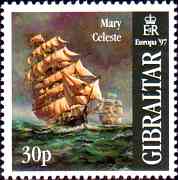In Valerie Martin’s new The Ghost of the Mary Celeste, famed British author and Sherlock Holmes creator Arthur Conan Doyle is touring the United States. Though gracious among his fans, Doyle finds every dinner, interview, lecture, or appearance to be wearyingly predictable: the American penchant for steam heat will render him miserably warm; he will be implored to “bring back Sherlock Holmes“; he will yet again be solicited for his impressions of America.
One can sympathize; Americans’ love for cozy interior climates and Sherlock Holmes–and their self-assurance–are documented.
 And so is the Mary Celeste, an actual American ship discovered intact and adrift east of the Azores in 1872 with captain, crew, and the captain’s wife and daughter missing. The vessel’s enigmatic fate inspired an 1884 tale by Doyle titled “J. Habakuk Jephson’s Statement”. Appearing in the well-regarded Cornhill magazine, the story (though not attributed to Doyle at the time) paid the author well. Since the account plays a role in Martin’s multifaceted novel, readers, too, are handsomely rewarded.
And so is the Mary Celeste, an actual American ship discovered intact and adrift east of the Azores in 1872 with captain, crew, and the captain’s wife and daughter missing. The vessel’s enigmatic fate inspired an 1884 tale by Doyle titled “J. Habakuk Jephson’s Statement”. Appearing in the well-regarded Cornhill magazine, the story (though not attributed to Doyle at the time) paid the author well. Since the account plays a role in Martin’s multifaceted novel, readers, too, are handsomely rewarded.
Doyle’s melodramatic yarn is just one player in the story encompassing a tragic seafaring clan, a heartrendingly tender couple, a resolute female journalist, a long-missing diary, and a charismatic young woman seemingly mystified by her ability to receive messages from the dead.
The ghost in the title isn’t one that haunts the vessel; it has more to do with the spirit of America at the time: the national obsession with psychic phenomena such as “mediums” who allegedly bridged communication between the living and the dead. Both sea voyages and the 19th-century Spiritualism Movement attracted participants willing to venture beyond their elements–some merely extracting adventure from the experience, others forever losing their way.
I particularly enjoyed Martin’s description of Pleasant Lake, a sort of Spiritualist resort, complete with séances, clairvoyant physicians, magnetic healers, and spirit photographers.
Viewing artifact photos of that time, we could scoff at the obvious fakery employed to produce depictions of, say, a widower shadowed by a faint image of his wife’s “spirit”–or we could imagine how a lesser degree of sophistication combined with extreme grief could bring the possessor to find comfort in them. Though fictional, Martin’s book reflects significant historical research and thus affords an authentic sense of this era in American history.
Some elements reflect our consciousness today. You need only glance at a TV schedule or new book display for evidence of our fascination with the paranormal. And as for creative attempts to portray a life beyond fact–check out all the strategically chosen, digitally altered, and idealized shots featured on Facebook profiles.
I’m not sure what it says about me that my Facebook profile shot is a Mad Men-style cartoon of a sheath-clad, bespectacled lady clutching a coffee cup. A friend commented, “You do know that’s not very flattering, right?” I could only respond in the immortal words of Pigpen in A Charlie Brown Christmas: “On the contrary–I didn’t think I looked that good.”


